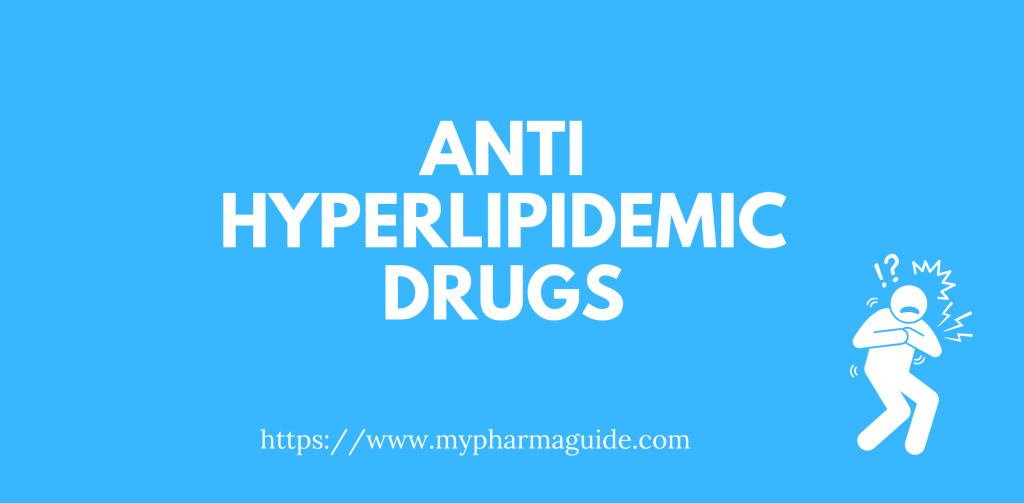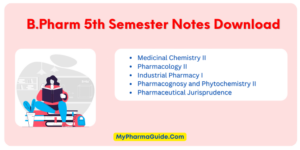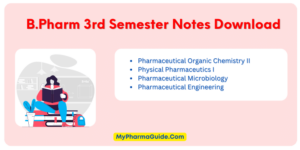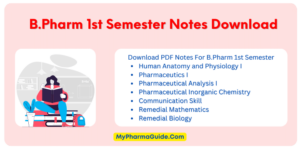Get Latest Updates About Pharmacy Notes, Books and Many More
Anti Hyperlipidemic drugs are used to lower the levels of lipids and lipoproteins in the blood. Some examples of antihyperlipidemic are Atorvastatin, Rosuvastatin, Colestipol, Fenofibrate, Omega-3 fatty acids, etc. In this note, we will learn about the Classification of Anti Hyperlipidemic Drugs, Mechanism of Action, Adverse Effects, Therapeutic Effects, and Drug Interactions. For more study notes keep visiting MyPharmaGuide.
Introduction of Anti Hyperlipidemic Drugs
The hypolipidaemic drugs have attracted considerable attention because of their potential to prevent cardiovascular disease by retarding the accelerated atherosclerosis in hyperlipidaemic individuals.
Lipids or fats, which are usually transported in various combinations with proteins (lipoproteins), play a key role in cardiovascular disorders. Lipids, including cholesterol and triglycerides, are essential elements in the body. They are synthesized in the liver; therefore, they can never be eliminated from the body. Anti Hyperlipidemic Drugs are the group of drugs prescribed in adjuvant therapy to reduce elevated cholesterol levels in patients with high cholesterol and LDL levels in the blood
Classification of Anti Hyperlipidemic Drugs
Antihyperlipidemics are classified between the following types:
- HMG-CoA reductase inhibitors (Statins): Lovastatin, Simvastatin, Pravastatin, and Atorvastatin.
- Bile Acid Sequestrants (Resins): Cholestyramine and Colestipol
- Fibric Acid Derivatives (Fibrates): Clofibrate, Gemfibrozil, Bezafibrate, and Fenofibrate.
- Triglyceride Synthesis and Lipolysis Inhibitors: Nicotinic acid
- Others: Probucol and Omega-3 fatty acids

HMG-CoA Reductase Inhibitors (Statins)
Statins are the most effective and best-tolerated agents used to treat hyperlipidemia. Statins are competitive inhibitors of 3 -hydroxy-3-methylglutarylcoenzyme reductase and also the most effective and best-tolerated agents for treating hyperlipidemia. They catalyze an early, rate-limiting step in cholesterol biosynthesis. Higher doses are more potent and can even reduce the triglyceride levels caused by high VLDL levels.
Mechanism of Action
- Statins are the most potent LDL reducers.
- They are structural analogs of HMG-CoA
- Statins competitively inhibit the HMG-CoA reductase enzyme
- Statins block the rate-limiting step in hepatic cholesterol synthesis (conversion of hydroxymethyl glutaryl coenzyme A (HMG-CoA) to mevalonate by HMG-CoA reductase)
- Low intracellular cholesterol stimulates the synthesis of LDL receptors
- Promote uptake of LDL from the blood
- Low intracellular cholesterol decrease the secretion of VLDL to the blood
- Statins have direct anti-atherosclerotic effects and have been shown to prevent bone loss

Therapeutic Uses
Therapeutics uses of Statins are given below:
- Statins are used for secondary prevention of myocardial infarction and stroke in patients having the symptomatic atherosclerotic disease (e.g., angina, transient ischemic attacks, following acute myocardial infarction or stroke).
- They are used for the primary prevention of arterial disease in patients having high risk due to increased serum cholesterol concentration, specifically when there are other risk factors for atherosclerosis.
- Serum cholesterol levels can be lowered by atorvastatin in patients with homozygous familial hypercholesterolemia.
- A bile acid-binding resin is added to treatment with a statin in cases of severe drug-resistant dyslipidemia (e.g., heterozygous familial hypercholesterolemia).
Adverse Effects
All statins are remarkably well tolerated; the overall incidence of side effects not differing from placebo. Notable side effects are: Gastrointestinal complaints and headaches are usually mild. Rashes and sleep disturbances are uncommon. The rise in serum transaminase can occur, but liver damage is rare. Monitoring of liver function is recommended.
Individual Drugs
Atorvastatin: This newer and most popular statin is more potent and appears to have the highest LDL-CH lowering efficacy at a maximal daily dose of 80 mg. At this dose, a greater reduction in TGs is noted if the same was raised at baseline. Atorvastatin has a much longer plasma t½ of 18– 24 hr than other statins and has additional antioxidant property.
Lovastatin: It is the first clinically used statin; is lipophilic and given orally in the precursor lactone form. Absorption is incomplete and first-pass metabolism is extensive. Metabolites are excreted mainly in bile. The t½ is short (1–4 hours).
Simvastatin: It is twice as potent as lovastatin; also more efficacious. A greater rise in HDLCH (when low) has been noted with simvastatin than lovastatin or pravastatin. Like lovastatin, it is lipophilic and given in the lactone precursor form. Oral absorption is better and first-pass metabolism extensive; t½ is 2–3 hr.
Bile Acid Sequestrants (Resins)
Mechanism of Action
Bile acid sequestrants are polymeric compounds that act as ion exchange resins. They exchange anions (like Cl− ions) for bile acids by binding with bile acid and sequestering them from enterohepatic circulation. They are not well-absorbed from the gut into the bloodstream because they have large polymeric structures. Therefore, the bile acid sequestrants along with the bile acid bound to the drug, are excreted via feces after passing through the gastrointestinal tract.
Therapeutic Uses
- Bile acid sequestrants are used for the treatment of hypercholesterolemia and dyslipidemia as they help in decreasing cholesterol levels.
- For patients with chronic liver diseases, bile acid sequestrants may be used for the prevention of pruritus.
- They are also used in the treatment of diarrhea caused by excess bile salts entering the colon rather than being absorbed in the end of the small intestine.
Adverse Effects
Bile acid sequestrants do not have any systemic side effects because they are designed to stay in the gut. However, they may cause problems like constipation, diarrhea, and flatulence in the gastrointestinal tract.
Individual Drug
Cholestyramine: Cholestyramine acts by preventing the reabsorption of bile in the gastrointestinal tract. It binds to bile as it is a strong anion exchange resin that can exchange its chloride anions with anionic bile acids in the GIT and bind them in the resin matrix strongly.
Fibric Acid Derivatives (Fibrates)
The fibrates (isobutyric acid derivatives) primarily activate lipoprotein lipase which is a key enzyme in the degradation of VLDL resulting in lowering of circulating TGs.
Mechanism of Action
The mechanism of action of fibrates is not completely understood but it is believed that they increase peripheral clearance and reduce hepatic triglyceride synthesis. The effects given by fibrates on blood lipids depend on their binding to Peroxisome Proliferators Activator Receptors (PPARs), which regulate gene transcription. alpha, beta, and gamma are the three PPAR isotopes
that have been identified. Fibrates act as agonists for the nuclear transcription factor Peroxisome Proliferators-Activated Receptor-alpha (PPAR-alpha), at the molecular level.
This mechanism is used by fibrates for the downregulation of the apolipoprotein C-III (apo C-III) gene and up-regulation of the genes for apolipoprotein A -I (apo A-I), fatty acid transport protein, fatty acid oxidation, and LPL. Thus, VLDL triglycerides get reduced due to the enhanced catabolism of triglycerides by LPL along with enhanced fatty acid oxidation.
Therapeutic Uses
Therapeutic uses of fibrates are given in the below list
- Fibrates (gemfibrozil) are the first -line of drugs for patients with type III hyperlipidemia or familial dysbetalipoproteinemia.
- They are used to treat mixed hyperlipidemia, wherein the predominant abnormality is hypertriglyceridemia (in combination with resins), and to treat moderate to severe hypertriglyceridemia.
- They are used with statins in patients with a high risk of CHD and mixed hyperlipidemia. But because of the increased risk of myopathy, careful safety monitoring is required.
Adverse Effects
Generally, fibrates do not give any adverse reaction and are well-tolerated in most patients. But in some patients, minor side -effects like GI disturbance symptoms like abdominal pain, diarrhea, and nausea may be seen that are corrected by the discontinuation of the treatment.
An important but rare adverse effect of fibrates is myositis with muscle pain and tenderness and elevated creatinine kinase levels. Fibrates are contraindicated in patients with renal dysfunction, as they get accumulated in the kidney leading to the enhanced frequency of adverse effects
specially myositis.
Individual Drugs
Clofibrate: Clofibrate enhances lipoprotein triglyceride lipolysis by increasing the activity
of extrahepatic Lipoprotein Lipase (LL). Degradation of chylomicrons converts VLDLs to LDLs, which are further converted into HD Ls. These changes occur by a minor increase in the secretion of lipids into bile and finally in the intestine.
Triglyceride Synthesis and Lipolysis Inhibitors
Nicotinic Acid (Niacin)
Nicotinic acid is an organic compound that belongs to the pyridine carboxylic acids group of compounds. At high concentrations, this drug gives cholesterol and triglyceride-lowering effects, resulting in a decrease of LDLs and VLDLs and an increase in HDLs.
Mechanism Of Action
Nicotinic acid helps in the inhibition of the release of free fatty acids from adipose tissue and enhances lipoprotein activity. It results in an increased rate of triglyceride removal from plasma. These actions decrease the total LDL (bad cholesterol) and triglyceride levels, causing increased HDLs (good cholesterol).
Therapeutic Uses
Nicotinic acid is not used therapeutically due to its side effects but sometimes can be prescribed as an adjunct to diet for treatment of high serum triglyceride levels in adult patients who have a risk of pancreatitis, and who do not respond properly to dietary control.
Adverse Effects
The major adverse effects of nicotinic acid are headache, anxiety, hypotension, dry skin, flushing or burning of the skin, peptic ulcer, and abnormal liver function tests.
Other mild adverse effects are hyperuricemia, glucose intolerance, nausea, vomiting, diarrhea, hyperglycemia, and elevated plasma uric acid.
Probucol
It helps in the reduction of LDL and HDL levels, but shows minute effects on serum-triglyceride or VLDL cholesterol levels.
Mechanism of Action
Probucol acts by increasing the fractional rate of LDL catabolism in the final metabolic pathway for cholesterol elimination from the body. This results in the reduction of serum cholesterol level s. It can also inhibit the early stages of cholesterol biosynthesis and slightly inhibit dietary
cholesterol absorption. According to recent studies, probucol can also control atherogenesis as it may inhibit the oxidation and tissue deposition of LDL cholesterol.
Therapeutic Uses
Probucol is used to lower LDL and HDL cholesterol levels.
Adverse Effects
The common adverse effects of probucol are dizziness or fainting and fast or irregular heartbeat.
Some rarely occurring adverse effects are swellings on the face, hands, or feet, or in the mouth, unusual bleeding or bruising, and unusual tiredness or weakness.
Other Anti Hyperlipidemic Drugs
Some rarely used anti hyperlipidemic drugs are omega-3 fatty acids (fish oils).
Mechanism Of Action
Hepatic VLDL triglyceride synthesis is reduced by omega -3 fatty acids, thus, reducing the plasma triglyceride levels. Secretion of VLDL apo B is reduced at high doses of omega -3 fatty acids. The triglyceride levels are reduced at low doses of omega -3 fatty acids, but LDL cholesterol levels may rise due to the conversion of VLDL to LDL -HDL cholesterol. Because of the decrease in thromboxane synthesis, fish oils also have antiplatelet aggregatory activity.
Plasma fibrinogen levels are also reduced.
Adverse Effects
The most common side effect of fish oils is nausea. However, their long-term use
has no obvious side effect.
Therapeutic Uses
Therapeutic uses are listed below:
- Fish oils, available as gelatin capsules are used in severe hypertriglyceridemia along with fibrates.
- Fish oils along with statins (LDL-C may increase during monotherapy, thus they should not be used alone) are helpful in patients having mixed hyperlipidemia with a slight increase in triglycerides.
Disclaimer
The content of mypharmaguide.com is provided for information and educational purposes only. We are not owner of the any PDF Material/Books/Notes/Articles published in this website. No claim is made as to the accuracy or authenticity of the PDF Material/Books/Notes/Articles of the website. In no event will this site or owner be liable for the accuracy of the information contained on this website or its use. mypharmaguide.com provides freely available PDF Material/Books/Notes on the Internet or other resources like Links etc. This site does not take any responsibility and legal obligations due to illegal use and abuse of any service. No responsibility is taken for any information that may appear on any linked websites.
Conclusion
If you also want to submit your notes to help students you can contact us for submitting your notes. To contact us click here. If you find this post ” Anti Hyperlipidemic Drugs Free Pharmacology Note – 2021 “ helpful then share it with your friends also.
Download our android app click here. You can find the latest versions of many pdf books, the latest collection of university question papers, MCQ Quiz test, and update via notifications. Our app is completely ad-free and no need to register in our app to use it. Why waiting to download it now from Google Play Store.



Whʏ visitors still use to read news papers when in this technological world everything iѕ existing on web?
Great stuff.Id like to recommend checking out a lot around the idea of french fries. What exactly are you looking for though?